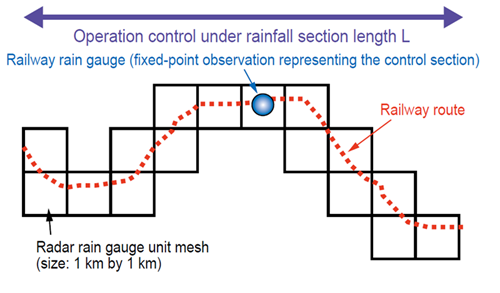2. Method for Setting Regulation Values for Operation Control Under Rainfall Using Radar Rain Gauges
Currently, railway rain gauges are installed at intervals of several tens of kilometers, and operation control under rainfall based on rainfall observed at these fixed points may fail to detect localized heavy rain occurring far from the gauges. To address this issue, the introduction of radar rain gauges, which can monitor rainfall over a wide area, is being considered (Figure 1). In this study, we proposed an easy method to set regulation values for radar rain gauges based on the regulation values of existing railway rain gauges and information such as their installation intervals. Specifically, when an operation control is issued due to the radar-measured rainfall in any unit mesh within the operation control under rainfall section (Figure 1) exceeding the current regulation value, the rainfall observed by the radar rain gauge tends to be higher than that of the railway rain gauge (Figure 2, with the average increase factor denoted as rainfall conversion factor α). This may cause a significant increase in restriction issuance time, raising concerns about excessive protectionism. Therefore, the regulation value for the radar rain gauge is set by multiplying the rainfall conversion factor α by the existing railway rain gauge regulation value. We also analyzed the relationship between the average operation control under rainfall section length L and the rainfall conversion factor α (Figure 3), enabling easy determination of α based on this relationship. The simulation results showed that in cases where the regulation values for radar rain gauges were set using this method (B and C in Figure 4), compared to the current case with existing regulation values set for railway rain gauges (A in Figure 4), the regulation time slightly increased while the number of captured disaster events also increased. This indicates improved safety without excessively extending the regulation time (D in Figure 4).
Other Contents
- 1. Performance Evaluation Method for Earthquake Early Warning Systems
- 2. Method for Setting Regulation Values for Operation Control Under Rainfall Using Radar Rain Gauges
- 3. Method for Estimating Track Buckling Risk Based on On-board Measurements
- 4. Method for Identifying Wheel Usage Limit Temperature and Evaluating Safety While in Service
- 5. Investigation of Front Rod Fracture Causes and Maintenance Methods to Prevent Fracture
- 6. Detection System for DC High-resistance Ground Faults by Utilizing the Current Data of Both Substations and Vehicles
- 7. Forward Obstacle Detection System for Trains in Preparation for Future Driverless Operation
- 8. Validation of the Long-term Effectiveness of Automatic Deerdeterrent Sound Devices
- 1. Performance Evaluation Method for Earthquake Early Warning Systems
- 2. Method for Setting Regulation Values for Operation Control Under Rainfall Using Radar Rain Gauges
- 3. Method for Estimating Track Buckling Risk Based on On-board Measurements
- 4. Method for Identifying Wheel Usage Limit Temperature and Evaluating Safety While in Service
- 5. Investigation of Front Rod Fracture Causes and Maintenance Methods to Prevent Fracture
- 6. Detection System for DC High-resistance Ground Faults by Utilizing the Current Data of Both Substations and Vehicles
- 7. Forward Obstacle Detection System for Trains in Preparation for Future Driverless Operation
- 8. Validation of the Long-term Effectiveness of Automatic Deerdeterrent Sound Devices




